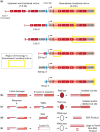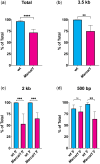The effect of repeat length on Marcal1-dependent single-strand annealing in Drosophila
- PMID: 36303322
- PMCID: PMC9836020
- DOI: 10.1093/genetics/iyac164
The effect of repeat length on Marcal1-dependent single-strand annealing in Drosophila
Abstract
Proper repair of DNA double-strand breaks is essential to the maintenance of genomic stability and avoidance of genetic disease. Organisms have many ways of repairing double-strand breaks, including the use of homologous sequences through homology-directed repair. While homology-directed repair is often error free, in single-strand annealing homologous repeats flanking a double-strand break are annealed to one another, leading to the deletion of one repeat and the intervening sequences. Studies in yeast have shown a relationship between the length of the repeat and single-strand annealing efficacy. We sought to determine the effects of homology length on single-strand annealing in Drosophila, as Drosophila uses a different annealing enzyme (Marcal1) than yeast. Using an in vivo single-strand annealing assay, we show that 50 base pairs are insufficient to promote single-strand annealing and that 500-2,000 base pairs are required for maximum efficiency. Loss of Marcal1 generally followed the same homology length trend as wild-type flies, with single-strand annealing frequencies reduced to about a third of wild-type frequencies regardless of homology length. Interestingly, we find a difference in single-strand annealing rates between 500-base pair homologies that align to the annealing target either nearer or further from the double-strand break, a phenomenon that may be explained by Marcal1 dynamics. This study gives insights into Marcal1 function and provides important information to guide the design of genome engineering strategies that use single-strand annealing to integrate linear DNA constructs into a chromosomal double-strand break.
Keywords: DNA repair; DSB repair; annealing.
© The Author(s) 2022. Published by Oxford University Press on behalf of Genetics Society of America.
Conflict of interest statement
Conflicts of interest: None declared.
Figures




Similar articles
-
Annealing of Complementary DNA Sequences During Double-Strand Break Repair in Drosophila Is Mediated by the Ortholog of SMARCAL1.Genetics. 2017 May;206(1):467-480. doi: 10.1534/genetics.117.200238. Epub 2017 Mar 3. Genetics. 2017. PMID: 28258182 Free PMC article.
-
Single-Strand Annealing Plays a Major Role in Double-Strand DNA Break Repair following CRISPR-Cas9 Cleavage in Leishmania.mSphere. 2019 Aug 21;4(4):e00408-19. doi: 10.1128/mSphere.00408-19. mSphere. 2019. PMID: 31434745 Free PMC article.
-
Regulation of Single-Strand Annealing and its Role in Genome Maintenance.Trends Genet. 2016 Sep;32(9):566-575. doi: 10.1016/j.tig.2016.06.007. Epub 2016 Jul 19. Trends Genet. 2016. PMID: 27450436 Free PMC article. Review.
-
The Role of Drosophila CtIP in Homology-Directed Repair of DNA Double-Strand Breaks.Genes (Basel). 2021 Sep 16;12(9):1430. doi: 10.3390/genes12091430. Genes (Basel). 2021. PMID: 34573412 Free PMC article.
-
Pathways and assays for DNA double-strand break repair by homologous recombination.Acta Biochim Biophys Sin (Shanghai). 2019 Sep 6;51(9):879-889. doi: 10.1093/abbs/gmz076. Acta Biochim Biophys Sin (Shanghai). 2019. PMID: 31294447 Review.
Cited by
-
Transgene removal using an in cis programmed homing endonuclease via single-strand annealing in the mosquito Aedes aegypti.Commun Biol. 2024 May 29;7(1):660. doi: 10.1038/s42003-024-06348-6. Commun Biol. 2024. PMID: 38811748 Free PMC article.
-
The epistatic relationship of Drosophila melanogaster CtIP and Rif1 in homology-directed repair of DNA double-strand breaks.G3 (Bethesda). 2024 Nov 6;14(11):jkae210. doi: 10.1093/g3journal/jkae210. G3 (Bethesda). 2024. PMID: 39397376 Free PMC article.
-
Repeat mediated excision of gene drive elements for restoring wild-type populations.PLoS Genet. 2024 Nov 7;20(11):e1011450. doi: 10.1371/journal.pgen.1011450. eCollection 2024 Nov. PLoS Genet. 2024. PMID: 39509462 Free PMC article.
References
-
- Baradaran-Heravi A, Cho KS, Tolhuis B, Sanyal M, Morozova O, Morimoto M, Elizondo LI, Bridgewater D, Lubieniecka J, Beirnes K, et al. Penetrance of biallelic SMARCAL1 mutations is associated with environmental and genetic disturbances of gene expression. Hum Mol Genet. 2012;21(11):2572–2587. - PMC - PubMed
Publication types
MeSH terms
Substances
Grants and funding
LinkOut - more resources
Full Text Sources
Molecular Biology Databases
Research Materials

